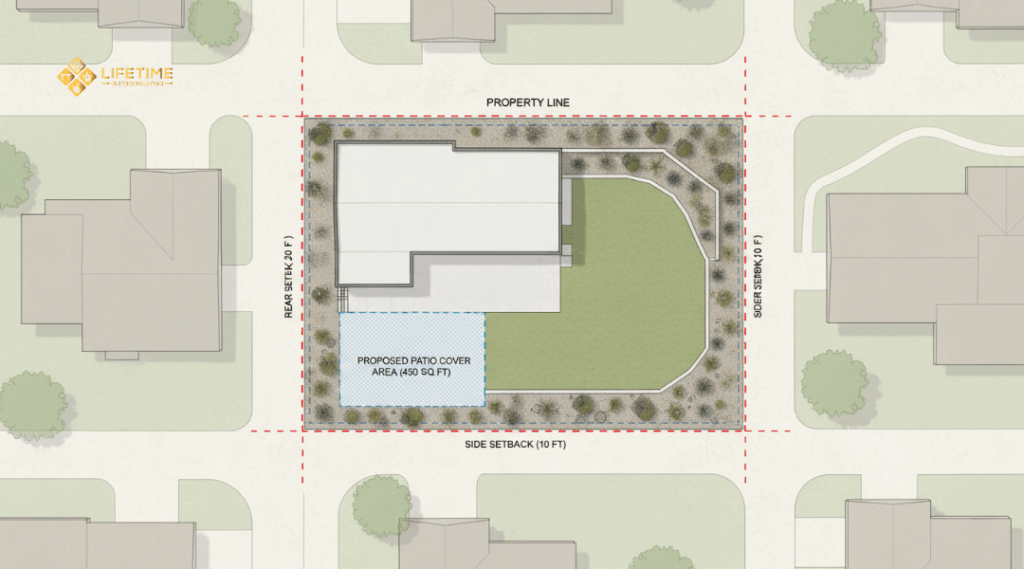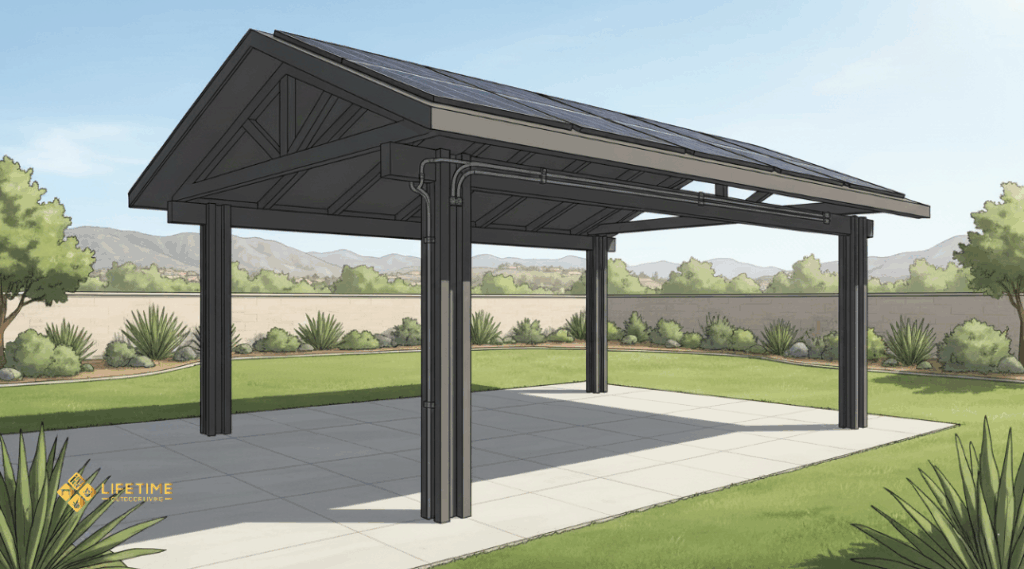Adding a patio cover can transform your backyard into a comfortable, shaded retreat, but before construction begins, you need to know what local rules apply. In Orange County, you must obtain a building permit for most patio covers, whether attached or freestanding, to ensure the structure meets safety and zoning standards. Skipping this step can lead to costly fines, project delays, or even removal orders.
Understanding the permit process helps you plan your project with confidence. Orange County’s regulations vary depending on your property’s location—unincorporated areas fall under OC Planning, while incorporated cities manage their own permitting. Each jurisdiction may have different setback, height, and material requirements, so confirming these details early prevents surprises later.
When you work with a licensed contractor like Lifetime Outdoor Living, the permit process becomes smoother and more efficient. Their team handles design, documentation, and coordination with local agencies, allowing you to focus on creating an outdoor space that fits your lifestyle and enhances your home’s value.
Why Patio Cover Permits Matter
Building a patio cover in Orange County involves more than design and materials. You must also meet local building and safety standards that protect your property value, ensure structural integrity, and prevent costly code violations.
Purpose of Building Permits and Code Compliance
A building permit confirms that your patio cover meets California Building Code and local zoning standards. It ensures the structure can withstand weather loads, is properly anchored, and maintains safe distances from utilities and property lines.
Permits also trigger inspections by county or city officials. These inspections verify that work follows approved plans and complies with electrical, structural, and fire safety requirements.
In Orange County, patio covers—especially attached or aluminum types—often need Orange County Fire Authority (OCFA) approval before final permitting. This step is crucial if your property lies in a high fire hazard severity zone.
Having a valid permit provides a documented record of compliance. It becomes part of your property’s official file, which helps during home sales, refinancing, or insurance claims, since unpermitted structures can delay or complicate those processes.
Consequences of Skipping the Permit Process
Building without a permit can lead to code enforcement actions, including stop-work orders, fines, or mandatory demolition. Orange County typically opens investigations after receiving public complaints, and inspectors can require you to remove or modify unapproved work.
Unpermitted patio covers may also create legal and financial risks. Future buyers or lenders can demand proof of permits before approving transactions, and insurance carriers may deny coverage for damage to unpermitted structures.
If discovered later, you might need to apply for a retroactive permit, which often costs more and requires detailed inspections. In some cases, noncompliant designs cannot be legalized, forcing full removal and reconstruction to meet current standards.
Understanding Local Regulations in Orange County
Local building rules in Orange County vary depending on whether your property lies within a city boundary or an unincorporated area. You must also consider zoning designations, property setbacks, and any private restrictions imposed by homeowners’ associations before beginning construction.
County vs. City Jurisdiction (Laguna Beach, Irvine, Newport Beach, etc.)
Orange County’s unincorporated areas fall under the authority of OC Development Services. If your property is outside city limits, you apply for permits through the County’s Building and Safety Division. These projects often require review by the Orange County Fire Authority (OCFA), especially in high fire hazard zones.
Within incorporated cities—such as Laguna Beach, Irvine, or Newport Beach—you must follow each city’s building department procedures. For example, the City of Irvine enforces its own Residential Patio and Accessory Structure Standards, which specify allowable materials, height limits, and minimum setback distances from property lines.
City jurisdictions may also require design review or neighborhood compatibility checks. Always verify whether your property lies within city limits before submitting a permit application. Contact the appropriate city planning office to confirm submittal requirements, inspection procedures, and any additional fees.
Zoning Codes, Property Lines, and HOA Restrictions
Zoning codes determine where you can build and how close structures can be to property boundaries. Setback requirements—the minimum distance between a patio cover and a property line—vary by zoning district and lot type. Zero-lot-line neighborhoods, such as some in Turtle Rock or University Park, may leave little or no side yard space for new structures.

Before building, check your parcel’s zoning map and review any easements that might restrict construction. Encroaching into utility or drainage easements can trigger permit denials or required modifications.
If you live in an area governed by a Homeowners’ Association (HOA), you must obtain written architectural approval before applying for a city or county permit. HOAs often regulate color, material, and design consistency to preserve neighborhood appearance. Keeping documentation from both the HOA and local agency will help prevent delays during plan review.
Types of Patio Covers That Require Permits
Permit requirements depend on how a patio cover connects to your home, the materials used, and whether it’s a manufactured or custom-built design. Local building codes in Orange County set specific standards for safety, structural integrity, and property setbacks that determine when a permit is needed.
Attached vs. Freestanding Structures
An attached patio cover connects directly to your home’s exterior wall or roofline. Because it alters the building’s structure and can affect load distribution, you almost always need a building permit. The city reviews these projects to ensure proper attachment, drainage, and compliance with setback and fire safety rules.
Freestanding patio covers or gazebos stand independently from the house. You may still need a permit depending on the size, height, and distance from property lines. For example, a freestanding cover placed within a few feet of a fence or another structure often triggers a review for zoning compliance.
If your property is in a fire hazard zone or part of a homeowners association (HOA), additional approvals may apply. Always confirm whether your project encroaches on easements or violates neighborhood design restrictions before starting construction.
Solid Roof, Lattice, and Aluminum Covers
The type of roofing material affects whether a permit is required. Solid-roof patio covers, such as wood or insulated aluminum, are treated like small buildings because they provide full weather protection and can collect water. These structures typically require engineered plans and a building permit.
Open-lattice covers, which allow partial sunlight, may qualify for simplified approval if they meet city standards for spacing, height, and setbacks. In Irvine, for example, open-lattice designs that follow the city’s specifications often bypass the need for stamped engineering calculations.
Aluminum and louvered systems—especially those with motorized or adjustable panels—require permits due to their mechanical components and structural weight. Even prefabricated kits must show compliance with California Building Code wind and snow load requirements.
Prefabricated vs. Custom-Built Designs
Prefabricated patio covers come with manufacturer-engineered specifications. You still need a permit in most Orange County cities, but the documentation process is simpler. You must include the product’s engineering sheets and installation instructions with your permit application.
Custom-built designs require more detailed review. Plans must be drawn to scale and, if the structure exceeds six feet in height, stamped by a California-licensed engineer. This ensures the design meets structural and safety standards for your property’s zoning district.
If you plan to attach lighting, fans, or electrical outlets, you’ll also need an electrical permit. Whether prefabricated or custom, any patio cover that changes drainage patterns, adds load to the home, or alters property setbacks must be reviewed through your city’s online permitting system.
Structural and Safety Requirements
You must design and build your patio cover to meet structural stability, fire safety, and electrical code standards. Local building and fire agencies, such as the Orange County Fire Authority (OCFA), enforce these requirements to reduce hazards and ensure long-term safety.
Foundation, Posts, and Beam Sizing
Your patio cover’s foundation must provide stable support and prevent settlement. Most residential covers use concrete footings sized according to the weight of the structure and local soil conditions. The California Building Code (CBC) outlines minimum footing depths and reinforcement standards, typically requiring deeper foundations in soft or expansive soils.
Posts and beams must be sized based on span length, material type, and load. For example, a 4×4 post may support a small open-lattice cover, but larger spans often require 4×6 or 6×6 posts with engineered beams. Structural connectors, such as post bases and beam hangers, must be corrosion-resistant and rated for exterior use.
If you attach the patio cover to your home, verify that the existing wall or fascia can carry the additional load. Improper attachment can lead to structural failure or water intrusion, especially during heavy rain.
Wind Load and Seismic Zone Considerations
Orange County lies in a high wind and seismic activity zone, requiring compliance with CBC wind and earthquake design provisions. You must design your patio cover to resist lateral and uplift forces caused by Santa Ana winds and seismic movement.
Wind load ratings depend on your site’s exposure category and the structure’s height. Engineers often specify anchor bolts, shear connections, and diagonal bracing to prevent uplift or sway. In coastal or open areas, higher wind pressures may require thicker posts or deeper footings.
For seismic safety, the structure must be securely anchored to prevent separation during ground motion. Use approved anchor systems and avoid lightweight materials that can detach easily. The OCFA may require additional review if your property lies within a fire ordinance zone where wind-driven embers increase risk.
Electrical and Lighting Additions
If you plan to install lighting, fans, or outlets under your patio cover, you must follow California Electrical Code (CEC) standards. All wiring must be weather-rated and installed in conduit suitable for outdoor use.
Fixtures must carry a UL wet or damp location rating, depending on exposure. Junction boxes and switches should have gasketed covers to prevent moisture intrusion. Connect circuits to a ground-fault circuit interrupter (GFCI) to reduce shock hazards.
When adding new circuits, obtain an electrical permit and schedule an inspection with your local building department. If your patio cover is in a fire ordinance zone, OCFA may require that electrical components maintain clearance from combustible materials or vegetation.
Permit Application Process
You must apply for a building permit before starting construction on a patio cover in Orange County. The process involves submitting your permit application to the correct jurisdiction, preparing accurate documentation, and paying review and inspection fees. Each step ensures that your project meets local safety and zoning standards.
Where to Apply: OC Building Department or Local City Office
Where you submit your permit depends on your property’s location. If your home is in an unincorporated area of Orange County, you apply through OC Development Services. Properties within city limits, such as Irvine or Orange, require applications through the city’s Building and Safety Division.
Most cities, including Irvine, now use online systems like IrvineReady!, where you create an account, upload documents, and track review status. The County also offers electronic submittal options for efficiency.
You should confirm jurisdiction before applying. Use the county’s parcel search tool or contact the local planning counter to verify whether your address falls under county or city authority. Submitting to the wrong office can delay approval and require resubmission.
Required Documentation (Site Plan, Drawings, Specs)
Your application must include several key documents for review. A site plan shows the location of the patio cover in relation to property lines, structures, and easements. Include accurate dimensions and setbacks consistent with zoning requirements.
Construction drawings should detail materials, structural components, and connection methods. If the structure exceeds six feet in height or uses nonstandard materials, a California-licensed engineer must stamp and sign the plans.
Typical submittals include:
- Completed Building Permit Application form
- Residential Take-Off Sheet (for project details)
- Electronic Signature Disclosure
- Manufacturer cut sheets for pre-fabricated covers
- HOA approval letter, if applicable
Incomplete or inaccurate documentation often causes review delays, so verify all files before uploading.
Review Timelines and Typical Fees
After submission, staff review your application for completeness, usually within two business days. If additional details are needed, you’ll receive an email request. Once accepted, the technical review typically takes three to five business days for standard patio covers.
More complex or engineered designs may require longer review periods. You’ll be notified when fees are due before final approval.
Fees vary by city and project scope but generally include:
| Fee Type | Typical Range | Notes |
|---|---|---|
| Plan Check Fee | $150–$400 | Based on project size |
| Building Permit Fee | $100–$300 | Paid before issuance |
| Inspection Fee | $75–$150 | Covers field inspections |
You’ll receive a digital permit once all fees are paid and reviews are complete, allowing construction to begin legally.
Inspections and Final Approval
You must schedule and pass several inspections before the city issues a final approval for your patio cover permit. Inspectors verify that your construction meets approved plans, adheres to California Building Code, and satisfies local zoning and fire safety standards.
Pre-Construction Checks and Mid-Build Inspections
Before construction begins, confirm that your approved permit documents and stamped plans are available on-site. Inspectors will compare your work to these plans during each visit. Missing or outdated documents can delay inspection scheduling.
During construction, you may need foundation, framing, and electrical inspections depending on your patio cover design. For example, the Orange County Fire Authority (OCFA) may inspect fire-rated materials if your property lies in a Fire Ordinance Zone.
You or your contractor must request inspections through the city’s online portal or by phone. The responsible party must be present on-site with printed copies of the approved plans. Failure to provide access or documentation can result in a re-inspection fee.
Keep a record of all inspection approvals. Each stage must pass before moving to the next phase of work.
Final Walkthrough for Code Compliance
After construction, schedule a final inspection to verify code compliance and structural safety. The inspector will confirm that the patio cover matches the approved drawings and that all corrections from previous inspections have been addressed.
Typical items reviewed include:
| Inspection Focus | What Is Checked |
|---|---|
| Structure | Post-to-footing connections, beam spans, and roof attachment |
| Electrical | Proper installation of outlets, lighting, and grounding |
| Fire Safety | Approved materials, required clearances, and ember-resistant features |
You must also ensure that any required energy or insulation features meet Title 24 standards if applicable. Once the inspector signs off, the permit status changes to finaled, confirming that the patio cover complies with all building and zoning requirements.
Common Reasons for Inspection Failure
Inspection failures often occur when work deviates from the approved plans or when required documents are missing. Unpermitted design changes, such as altering roof materials or support spacing, can trigger re-submittal for plan check review.
Other frequent issues include:
- Improper post anchoring or inadequate footing depth
- Missing structural connectors or unapproved hardware
- Electrical installations without listed components
- Construction within setback or easement areas
To avoid delays, review your permit conditions and inspection checklist before scheduling. Correcting small issues early prevents costly re-inspections and helps you move efficiently toward final approval.
Exemptions and Streamlined Cases
Certain patio cover projects in Orange County fall under simplified review or may not require a full building permit. The determining factors usually include the structure’s size, permanence, and construction materials, as well as whether the property lies within city limits or an unincorporated area governed by OC Planning.
Small Covers Under Specific Size or Area Limits
Some small patio covers and open-lattice structures qualify for streamlined approval when they stay below local size thresholds. Many cities in Orange County exempt open-lattice covers under a certain square footage—often under 120 square feet—from full structural plan review.
However, these projects must still meet zoning setbacks, height limits, and fire safety clearances. You may need to submit a simple site plan showing distances to property lines and other structures.
If your design includes solid roofing or electrical work, you’ll likely need a standard building permit. Always confirm with the local building department or OC Planning before construction, since unincorporated areas follow county standards while incorporated cities apply their own codes.
| Type of Structure | Typical Size Limit | Common Requirements |
|---|---|---|
| Open-lattice patio cover | ≤120 sq. ft. | Site plan, zoning check |
| Solid-roof patio cover | Any size | Full permit and inspection |
| Small gazebo (non-enclosed) | ≤120 sq. ft. | Zoning clearance only |
Temporary or Decorative Shade Structures
Temporary or decorative shade structures—such as fabric canopies, pop-up gazebos, or lightweight aluminum frames—are often exempt when installed for short durations or non-permanent use.
You can generally use these for seasonal shading or events if they are not anchored to concrete, not wired for electricity, and removed within 180 days. If the structure stays up year-round or includes permanent foundations, it becomes subject to standard building review.
For safety, ensure the structure can withstand local wind conditions and does not block emergency access. Fire-retardant fabric may be required in high fire hazard zones, especially in unincorporated Orange County under OCFA oversight.
HOA Pre-Approval and Self-Certification Programs
If your property is part of a Homeowners Association (HOA), you may need HOA design approval before applying for a county or city permit. Many associations have architectural guidelines that restrict roof color, materials, or placement of patio covers and gazebos.
Some cities and developments in Orange County participate in self-certification programs for minor residential improvements. Under these programs, licensed contractors or engineers can certify that standard patio cover plans meet code without a full plan check.
This process shortens review time and reduces permit costs, but you must still schedule required inspections. Always keep copies of your HOA approval and certification forms for recordkeeping and future property disclosures.
Working with Licensed Contractors
Hiring a qualified contractor ensures your patio cover project meets Orange County’s building codes, safety standards, and inspection requirements. You protect yourself from liability, avoid costly corrections, and ensure the permit process moves efficiently from submission to final approval.
Why Using Licensed, Bonded, and Insured Pros Matters
A licensed contractor has met California’s professional standards set by the Contractors State License Board (CSLB). This license confirms technical competence and compliance with state regulations.
When a contractor is bonded, it means you have financial protection if the contractor fails to complete the work or violates the contract. Insurance—including general liability and workers’ compensation—protects you from property damage or injury claims during construction.
Hiring unlicensed workers can lead to fines, unsafe work, and permit rejections. Orange County requires that construction involving structural elements, such as patio covers, be performed by licensed professionals. You should always request written proof of license, bond, and insurance before signing any agreement.
Contractor’s Role in Permit Submission
Your contractor typically handles the permit application with the Orange County Development Services office. They prepare and submit the required plans, including structural drawings and site information, and coordinate with the Orange County Fire Authority (OCFA) if your property lies in a high fire hazard area.
A licensed contractor understands which documents need approval and how to respond to plan check comments. This knowledge helps avoid delays and ensures compliance with local codes.
During construction, the contractor schedules required inspections and addresses corrections noted by county inspectors. They also maintain communication with you about project milestones and permit status. Keeping copies of all permit documents and inspection reports helps you verify that the work was approved before final payment.
Verifying License and Insurance with CSLB
You can confirm a contractor’s credentials through the California Contractors State License Board (CSLB) website or by calling their automated phone system. Verification includes:
| Information to Check | Why It Matters |
|---|---|
| License number and status | Confirms the contractor is active and authorized to work. |
| Bond and insurance coverage | Ensures financial and liability protection. |
| Classification | Verifies the contractor is licensed for your specific project type. |
Always cross-check the contractor’s name, business address, and license number against the CSLB record. If any detail does not match, request clarification before moving forward. Keeping documentation of your verification protects you if disputes arise later.
Common Permit Mistakes to Avoid
Most patio cover permit issues in Orange County come from missing documentation, zoning missteps, or premature construction. Paying attention to plan accuracy, property setbacks, and official approval timelines helps you avoid delays, fines, and costly rework.
Submitting Incomplete Plans or Wrong Drawings
Incomplete or inaccurate submittals often cause review delays. The city requires a site plan, construction drawings, and a permit application package that clearly show property lines, structure dimensions, and materials. Missing or unclear details force reviewers to request revisions, extending the process.
If your patio cover exceeds 6 feet in height, you must include engineer-stamped drawings. Pre-fabricated kits also require manufacturer cut sheets signed by a California licensed engineer. Forgetting these can result in rejection.
Before uploading to the IrvineReady! portal, verify that all files are labeled correctly and digitally signed. Use the city’s checklists to confirm you’ve included every required form, especially if your property is part of an HOA or located in a Fire Ordinance Zone.
Ignoring Setback or Height Limits
Many permit denials stem from violating zoning setbacks and height restrictions. In most single-family zones, solid-roof patio covers must stay five feet from side property lines and ten feet from the rear, though this varies by district. Open-lattice and louvered covers usually require three-foot post setbacks and two-foot roof clearances from property lines.
Height limits also differ by area. For example, some Irvine neighborhoods cap patio cover height at 12 feet, while others allow up to 35 feet. Always confirm your zoning classification through the Online Parcel Search or by calling the Planning Counter (949-724-6308).
A quick review of your zoning map before submitting plans prevents costly redesigns. If you live in a community like Shady Canyon or Turtle Rock, double-check for special setback or easement rules that may apply.
Starting Work Before Approval
Beginning construction before permit approval is one of the most expensive mistakes. Doing so can trigger stop-work orders, fines, and even mandatory removal of unapproved structures. The city will not retroactively approve work that violates code or zoning standards.
You must wait for an official permit issuance notice through the IrvineReady! system before starting. Even minor grading or post installation counts as construction under local regulations.
If you hire a contractor, confirm they understand the city’s approval process and cannot begin until you receive written authorization. Keeping digital copies of your approval email and permit documents ensures you can show compliance during inspections.
Costs and Timelines in Orange County
Permit expenses and processing times in Orange County depend on project type, property location, and whether the site lies in an incorporated city or an unincorporated area managed by OC Development Services. You should account for plan review, inspection fees, and possible fire authority approvals when estimating both cost and schedule.
Average Permit and Inspection Fees
Building a patio cover in Orange County usually involves a building permit fee, plan check fee, and inspection fee. These costs vary based on project scope and whether the cover is attached or freestanding.
For simple residential patio covers, the county often uses a flat-fee system. Small projects may cost a few hundred dollars, while larger or custom structures can exceed $1,000 once plan review and inspection charges are included.
If OC Fire Authority approval is required—common in high fire hazard zones—additional review fees may apply. Payment can be made by cash, check, Visa, Mastercard, or American Express.
| Fee Type | Typical Range (USD) | Notes |
|---|---|---|
| Building Permit | $250–$900 | Depends on size and design |
| Plan Check | $100–$400 | Required for structural review |
| Inspection | Included or $100+ | Based on project type |
| Fire Authority Review | $100–$300 | Only in designated zones |
Timeframes for Approval and Build Completion
The processing time for a patio cover permit can range from a few days to several weeks. Over-the-counter permits for standard designs may be issued within one to three business days, while custom or engineered plans require formal plan review that can take two to six weeks.
OC Development Services coordinates with the Orange County Fire Authority when applicable, which can add one to two weeks for review. Once approved, inspections are typically scheduled within two to five days of request.
Construction timelines depend on contractor availability and material delivery. Simple aluminum or vinyl covers may be installed in one to three days, while larger wood-framed designs can take one to two weeks to complete after permit issuance.
Impact on Project Budgeting
You should include permit, design, and inspection costs in your total project budget to avoid unexpected expenses. For most residential patio covers in Orange County, permits and related fees represent 5–10% of total project cost.
Projects in fire hazard or coastal zones may face higher fees due to additional reviews and stricter building standards. If your property lies in an unincorporated area, expect separate coordination with OC Planning and OCFA, which can slightly extend both cost and time.
To manage expenses, request a fee estimate before submitting plans. This helps you plan cash flow, compare contractor quotes accurately, and prevent delays caused by incomplete or underfunded applications.
Green and Solar Patio Covers
You can design a patio cover that reduces energy use and supports renewable energy goals. These systems often involve solar panels or skylights, additional electrical and structural work, and may qualify for local or federal energy incentives.
Integrating Solar Panels or Skylights
You can install solar panels directly on a patio cover roof to generate electricity or power outdoor lighting. The structure must support the additional weight and wind load of the panels. In most Orange County cities, this requires permit review to confirm structural integrity and electrical safety.
If you prefer skylights, you can use tempered or laminated glass panels that allow natural light while maintaining weather protection. Skylights must be properly flashed and sealed to prevent leaks.
When adding solar or skylight features, you must submit detailed construction drawings showing connection points, roof slope, and electrical routing. The City of Irvine, for example, requires stamped engineering plans if structural changes exceed six feet in height or include electrical systems. Always verify that your design complies with both building and zoning codes before installation.
Extra Electrical and Structural Requirements
Solar-equipped patio covers add complexity to standard installations. You must follow California Electrical Code standards for wiring, grounding, and inverter placement. Electrical conduit must be weather-rated and securely fastened to structural members.

Structurally, the cover must support additional dead loads from panels, mounting rails, and wiring hardware. Most jurisdictions require certification from a licensed structural or civil engineer to confirm that posts, beams, and footings meet load-bearing requirements.
If you connect solar power to your home’s electrical system, you’ll also need utility approval through Southern California Edison or your local provider. A separate electrical permit may be required in addition to the building permit. Always include manufacturer cut sheets and engineering data for all solar components in your submittal package.
Incentives or Energy Credits Available
Installing solar-ready patio covers can make you eligible for federal and state incentives. The Federal Investment Tax Credit (ITC) allows you to claim a percentage of solar installation costs on your federal taxes. California also offers programs under the Self-Generation Incentive Program (SGIP) for battery storage systems paired with solar.
Some Orange County cities provide local rebates or expedited permitting for renewable energy projects. Check your city’s sustainability or building department for current offers.
If your patio cover system feeds electricity back to the grid, you may qualify for net energy metering (NEM), which credits your utility account for excess power generated. Keep records of all permits, equipment certifications, and inspection approvals to ensure eligibility for these programs.
How Lifetime Outdoor Living Handles Permits
Lifetime Outdoor Living manages the full permit process to keep your patio cover project compliant with Orange County regulations. The team coordinates design documentation, submits applications through city portals, and tracks approvals while keeping you informed at each step.
Turnkey Design, Documentation, and Submission
You receive a complete, start-to-finish permit service. Lifetime Outdoor Living prepares site plans, engineering drawings, and application packages that meet city and county building code standards.
The company uses digital submission systems such as IrvineReady! or other city-specific portals for electronic plan checks. This ensures your documents reach the correct department without delays caused by incomplete or incorrect formatting.
Before submission, your project manager verifies required materials, including HOA approvals, fire zone forms, and structural calculations when applicable. By handling every step internally, Lifetime reduces the chance of resubmittals or compliance issues later in the process.
| Step | Task | Responsible Party |
|---|---|---|
| 1 | Draft and review site plan | Lifetime design team |
| 2 | Gather engineering and HOA documents | Homeowner + Lifetime |
| 3 | Submit electronically to city portal | Lifetime permit coordinator |
| 4 | Track and respond to plan check comments | Lifetime permit coordinator |
Communication with City Inspectors and Homeowners
You stay informed through each stage of review and inspection. Lifetime Outdoor Living maintains direct contact with city planners, permit technicians, and building inspectors to clarify technical questions and schedule required site visits.
When inspectors request revisions or clarifications, the team updates drawings or calculations promptly to maintain momentum. You receive updates by email or phone so you always know the project’s status and next steps.
This proactive communication limits downtime between plan checks and inspections, helping your project move from approval to construction efficiently while maintaining transparency.
Ensuring Compliance with Lifetime Workmanship Warranty
Every permitted project must meet both city code and Lifetime’s internal standards for safety and durability. The company aligns permit-approved plans with its workmanship warranty, ensuring that materials, structural connections, and installation methods match approved specifications.
If a city inspection identifies a code-related issue, Lifetime corrects it before final approval so your warranty remains valid. This protects you from future disputes related to unpermitted or noncompliant construction.
By integrating permit compliance into its quality control process, Lifetime ensures your patio cover meets California Building Code requirements and qualifies for full warranty coverage once the project is complete.




